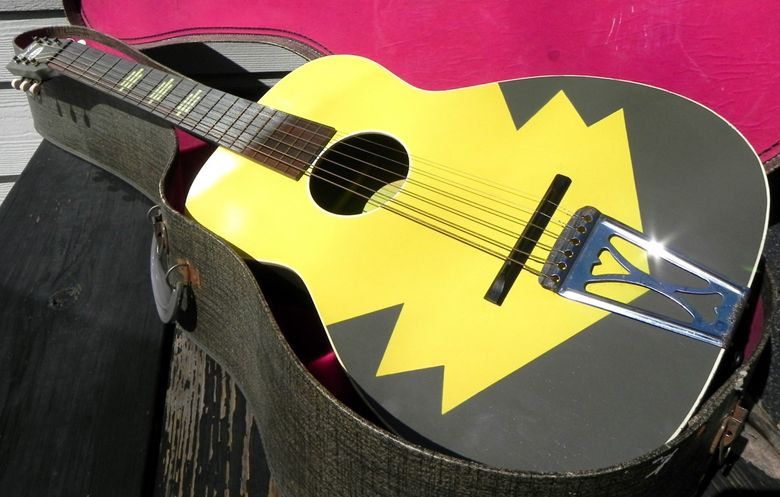guitarz.blogspot.com:
I often wish that contemporary acoustic guitar designs featured more interesting finishes. Usually if it isn't a natural finish, the most outlandish you can find is a completely black acoustic guitar - or else a pink one for girls.
Just look at this Stella Sundale by Harmony from 1955. Now there's a guitar that's going to get the player noticed with its grey finish emblazoned by what looks like an inverted yellow Christmas tree on the guitar's top. According to the eBay seller, "this was an art-deco series put out by Harmony in the mid-late 1950s, and this is the rarest model, as it was only offered in 1955." I've certainly seen photos of other Harmony/Stella guitars from this period with interesting coloured finishes, but this Sundale has to be the most eye-catching.
These guitars are not known for their fantastic acoustic response or particularly great playability, but as an affordable guitar for the masses they are still remembered fondly by many; some players even prefer their idiosyncratic qualities for rough and ready blues playing.
This example with original hard case is currently listed for sale on eBay with a Buy It Now price of $550.
G L Wilson
© 2013, Guitarz - The Original Guitar Blog - the blog that goes all the way to 11!



I used to have a Harmony-made Stella like this (but with a different finish). Mine was the usual sunburst with the painted-on faux curly maple look and painted-on binding. I've always thought those, again, painted-on inlays were one of the coolest inlay designs ever. My Stella was made in the Sixties, if I remember right. When I got it, it had a 1949 penny under the bridge to raise the action.
ReplyDeleteIt was an awesome little guitar. A bit hard to play with that wide flat f'board, and not a great tone, and lousy tuners. But it was a really fun guitar. Everybody should have one of these.
The good acoustic response of the Stellas came mainly from two things associated ; cheap light woods and cheap light finish.If the pieces of wood used were good enough, the instrument would last many years, if not it would fall apart very quickly. That's what gives their price to such instruments; those that survived are good ones! The boiled cardboard hardcase is also very interesting,it reminds me of my old "Teppaz" record player...
ReplyDelete